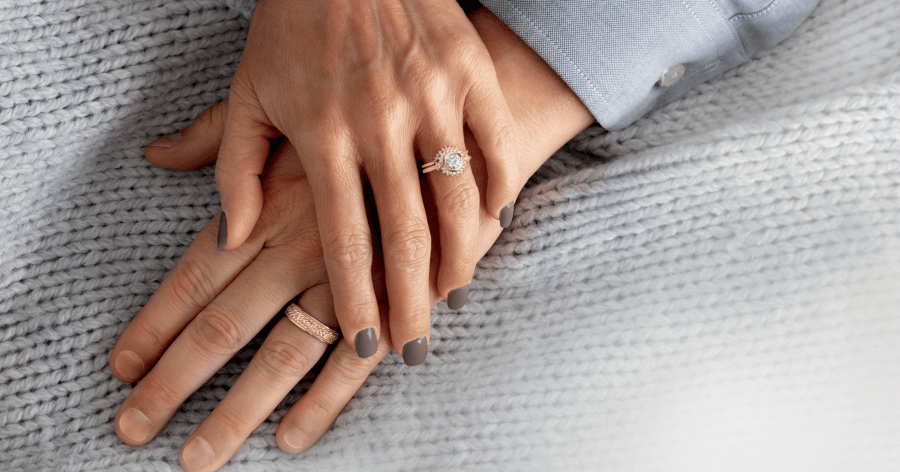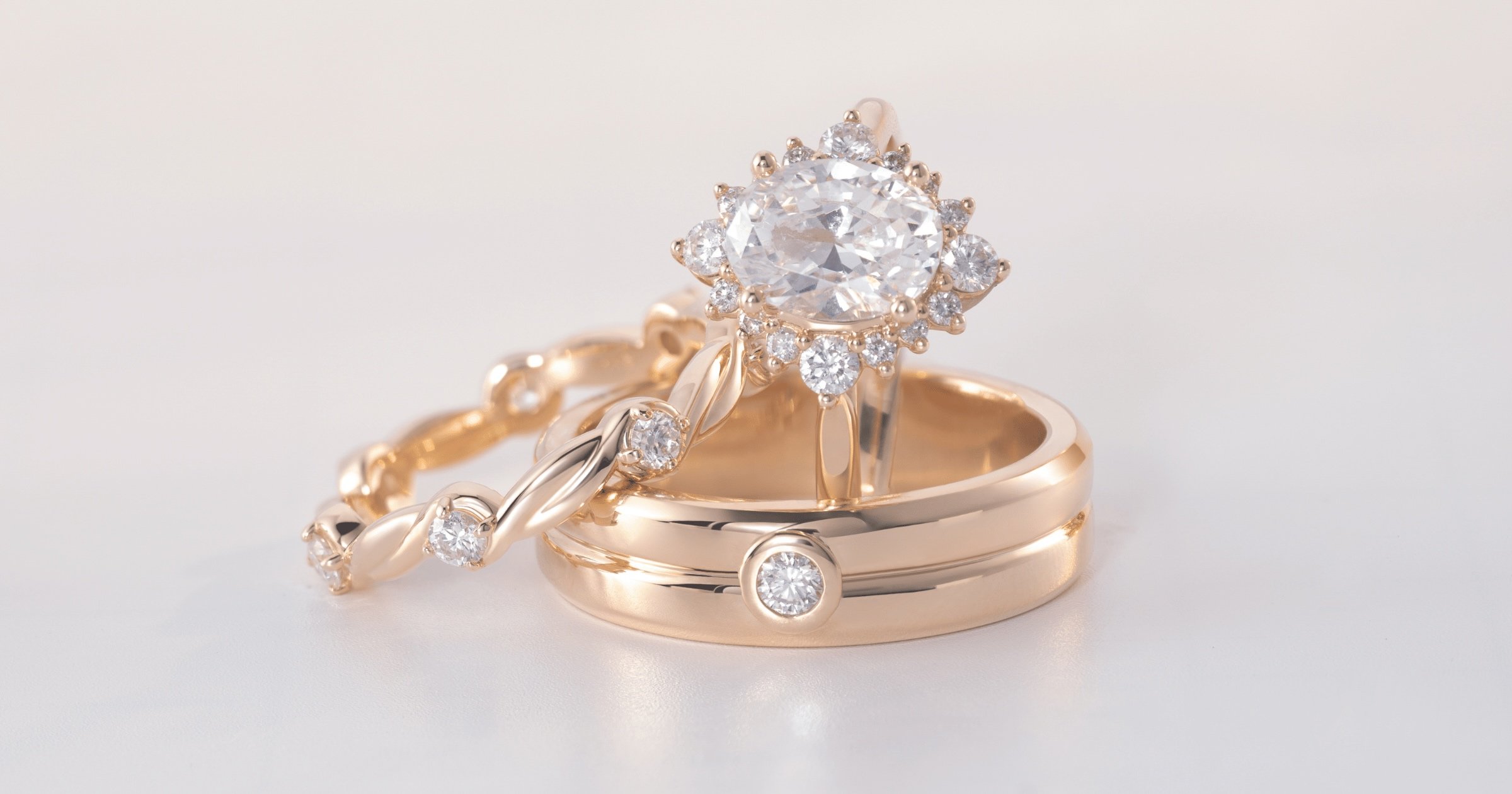The Difference Between Engagement Rings & Wedding Bands
- 10 mins
The sparkling "YES" has been uttered, the celebratory tears have been cried (and dried), and some new questions arise: What's the difference between an engagement ring and a wedding band? Do I need both? Who wears which? While both adorn the left ring finger, their purposes, styles, and traditions differ significantly. A common misconception is that an engagement ring might only be worn during the “engagement” period; however, an engagement ring is worn for a lifetime and is later complimented by the wedding band. Let's delve into the world of the differences between these symbolic circles of love, helping you navigate this exciting (and sometimes confusing) chapter!
Key Takeaways
- Engagement and wedding rings have distinct purposes. Engagement rings symbolize the promise to marry, while wedding bands mark the official union.
- There is no one-size-fits-all approach to choosing rings. The best choice depends on individual preferences, budgets, and the significance of the occasion.
- Rings hold sentimental value and can be passed down through generations. They serve as enduring symbols of love and commitment.
What Is an Engagement Ring?
An engagement ring signifies a couple's commitment to marry. It's a symbol of a promise, a declaration to the world that you've found your forever person and are embarking on the journey to wedded bliss. Traditionally presented during a proposal, the ring is worn throughout the engagement period, a constant reminder of the exciting future that awaits.
What Is a Wedding Ring?
Wedding bands (also known as wedding rings), on the other hand, represent the official act of making that promise a reality. Exchanged during the wedding ceremony, they mark the beautiful beginning of your marriage. Both partners typically wear wedding bands, symbolizing the equality and oneness within the union. It's a constant reminder, not just to the world, but to yourselves, of the vows promised and the love you share.
%20Solitaire%20Engagement%20Ring%20set%20with%20a%20Marquise%20Cut%20Diamond%3B%20White%20Gold%20(or%20Platinum)%20Wedding%20Band%3B%20White%20Gold%20(or%20Platinum)%20Wedding%20Band%20with%20Diamond%20Accents.png?width=900&height=473&name=White%20Gold%20(or%20Platinum)%20Solitaire%20Engagement%20Ring%20set%20with%20a%20Marquise%20Cut%20Diamond%3B%20White%20Gold%20(or%20Platinum)%20Wedding%20Band%3B%20White%20Gold%20(or%20Platinum)%20Wedding%20Band%20with%20Diamond%20Accents.png)
Differences Between Engagement and Wedding Rings
Engagement rings tend to be more elaborate, often featuring a central gemstone, such as a diamond, surrounded by intricate settings like halos or pavé diamonds. Wedding bands, on the other hand, are typically simpler in design, prioritizing comfort and practicality for everyday wear. They often feature a plain metal band or a band with subtle detailing.
There's also a growing trend towards "matching sets," where the wedding band is designed to compliment the engagement ring, allowing them to seamlessly stack together. Many couples also like to design coordinating wedding bands that feature the same metal colors or design elements.

Do You Need Both an Engagement and Wedding Ring?
While not strictly necessary, many couples choose to wear both an engagement ring and a wedding band. The engagement ring signifies the promise to marry, while the wedding band marks the fulfillment of that promise. However, some couples may opt for a single band that serves both purposes.
There's no right or wrong answer when it comes to engagement and wedding rings. The most important thing is to choose rings that hold meaning for you as a couple. Consider your budget, personal style, and the symbolism each ring represents.
How to Wear Your Engagement and Wedding Ring
Engagement rings often come with a heftier price tag. This reflects the intricate design, Traditionally, the engagement ring is worn on the left ring finger, with the wedding band worn on the bottom. However, there are no hard and fast rules, and couples can choose to wear them in any order or on different fingers.
For women, the wedding band and engagement ring are worn on the same finger typically with the wedding band worn on the bottom (since it is closest to your heart) and the engagement ring worn on top. Since men typically only wear one wedding band, they also wear it on their left-hand ring finger.
%20Wedding%20Band%20with%20Diamond%20Accents%3B%20Mens%20Yellow%20Gold%20Wedding%20Band.png?width=900&height=473&name=Womens%20White%20Gold%20(or%20Platinum)%20Wedding%20Band%20with%20Diamond%20Accents%3B%20Mens%20Yellow%20Gold%20Wedding%20Band.png)
Importance of Choosing the Right Rings
Choosing the right engagement and wedding rings is a significant decision. They are symbols of your love and commitment, and they should reflect your personal style and preferences. Consider your budget, the meaning you want the rings to hold, and the comfort level of the bands.
When choosing your rings, it's important to communicate openly with your partner about your expectations and style preferences. Do your research and explore different styles and materials before making a decision. You may also want to consider pre-loved options, such as family heirlooms or vintage rings.
What to Look for in an Engagement Ring
When choosing an engagement ring, consider the following factors:
- Center stone: The carat weight, color, cut, and clarity of the center stone are crucial.
- Setting: The setting holds the center stone and can significantly influence the overall look of the ring.
- Metal: Popular metals for engagement rings include platinum, white gold, yellow gold, and rose gold.
- Style: Choose a style that reflects your personal taste and the relationship's personality.
Engagement rings often feature a central gemstone, most popularly a diamond, though other precious stones like moissanites, sapphires, or emeralds are gaining traction. The setting can be intricate, with halos, pavé diamonds, or unique prongs adding to the ring's brilliance. The overall design often makes an eye-catching statement, reflecting the wearer's personality and style and showcasing the thought put into crafting the perfect ring.
What to Look for in a Wedding Ring
When selecting a wedding band, consider these factors:
- Metal: Wedding bands are often made of platinum, white gold, yellow gold, rose gold, or tungsten carbide.
- Style: Choose a style that complements your engagement ring or stands alone.
- Comfort: Ensure the band is comfortable to wear daily.
- Personalization: Consider adding engravings or other personal touches.
Wedding bands prioritize comfort and practicality for everyday wear. They are typically simpler in design, featuring a plain metal band (often platinum, yellow/white/rose gold, or tungsten carbide for mens' bands) or a band with subtle detailing. Some wedding bands incorporate small diamonds or gemstones, but these tend to be more minimalist compared to engagement rings.

Get the Most Out of Your Rings (and Marriage) with Faithful Platform
At Faithful Platform, our mission is to provide the highest quality rings at affordable prices while prioritizing trust and transparency. Request a free quote today and share your desired style. Our dedicated team will guide you through the process, helping you choose the perfect rings that symbolize your love and commitment. By saving on the rings, you can invest more in your marriage and build a stronger, more fulfilling relationship.

Frequently Asked Questions (FAQs)
Can you use your engagement ring as your wedding ring?
Yes, you can use your engagement ring as your wedding ring. Some couples choose to do this to save money or to have a single, meaningful piece of jewelry. However, if you prefer a different style for your wedding band, you can also purchase a separate one.
What happens to the engagement ring after the wedding?
After the wedding, the engagement ring is typically worn on the left ring finger, with the wedding band worn below it. It remains a symbol of the couple's commitment and is often passed down through generations.
Is the engagement ring fancier than the wedding ring?
Generally, yes, the engagement ring is fancier than the wedding ring. Engagement rings often feature a larger center stone and more intricate designs, while wedding bands tend to be simpler and more comfortable for everyday wear.
Does a bride get an engagement ring and a wedding ring?
Traditionally, a bride receives both an engagement ring and a wedding ring. The engagement ring is given as a symbol of the couple's commitment to marry, while the wedding ring is exchanged during the ceremony to mark the official union.
Why are wedding rings cheaper than engagement rings?
Wedding rings are often cheaper than engagement rings because they typically have simpler designs, smaller stones, or less precious metals. Additionally, wedding bands are designed for everyday wear, so they don't need to be as elaborate or expensive.
How much should an engagement ring cost?
The cost of an engagement ring can vary greatly depending on factors such as the carat weight, color, clarity, and cut of the center stone, the type of metal used, and the complexity of the setting. There is no set rule for how much an engagement ring should cost, but it's important to choose a ring that fits your budget and reflects a wise financial decision.
How much should a wedding ring cost?
The cost of a wedding ring can also vary widely, but it is generally less expensive than an engagement ring. Factors such as the metal, style, and any added features will influence the price. It's important to choose a wedding band that complements your engagement ring and fits within your budget.
